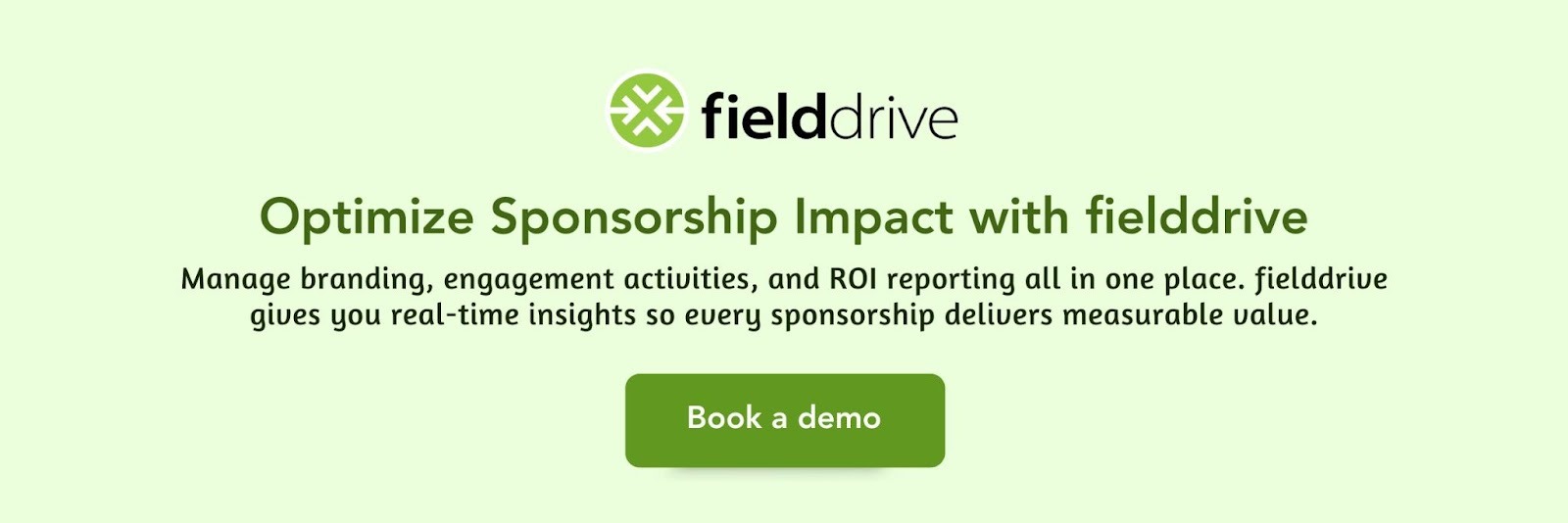How to Design Event Sponsorship Packages
Learn how to create event sponsorship packages that attract the right partners, deliver clear value, and increase engagement at every event.
.png)
CONTENT
Event sponsorships do more than fund your event. They add credibility and signal value to potential attendees. With around 31.6% of a company’s marketing budget often allocated to events and exhibiting, it's clear that strategic sponsorships matter.
A sponsorship package outlines what sponsors receive in return for their support, from visibility to engagement. It's a structured way to define expectations and ensure both organizers and sponsors see real outcomes.
When designed well, these packages elevate the entire event experience. This article shows you how to build sponsorship packages that stand out, attract the right partners, and deliver value that’s measurable and meaningful.
Key Highlights:
- Sponsorship packages work best when they balance clear options with room for custom input from sponsors.
- Engaging sponsors through proactive communication and personalized touchpoints strengthens trust and long-term collaboration.
- Visuals and concise presentations help sponsors grasp value quickly and make decisions confidently.
- Operational consistency, like trained staff and timely updates, ensures smooth execution and enhances sponsor satisfaction.
- Measuring outcomes with actionable insights turns event activity into evidence that supports future sponsorship decisions.
What Makes Event Sponsorship Packages Important?
These packages play a crucial role by securing funding for organizers while providing sponsors with targeted access, enhanced brand exposure, and valuable insights. At their core, sponsorship packages create mutually beneficial partnerships that strengthen the event and deliver clear value to everyone involved.
To turn this importance into action, it helps to understand the key components that make sponsorship packages effective. Here’s what to focus on.
Core Elements of Effective Sponsorship Packages
Focusing on the right elements helps you create offers that attract the right partners and deliver clear value. Let’s break down the core elements that make packages effective:
- Audience Demographics and Reach: Audience demographics help sponsors target their messaging effectively.
- Sponsorship Tiers and Benefits: Different levels provide flexible options customized to sponsor goals. Each tier offers specific perks so every sponsor feels their support has an impact. Clear benefits at every level set expectations and build trust.
- Branding Opportunities (On-site and Digital): Sponsors gain visibility in places that matter. Logos on banners, signage, event apps, and websites keep their brand in front of attendees throughout the experience.
- Engagement Activities (Speaking Slots, Networking, Activations): Giving sponsors ways to engage directly with attendees strengthens relationships. Opportunities to speak, host sessions, or run activations make their presence meaningful and memorable.
- Measurement and ROI Reporting: Providing numbers on attendance, engagement, and leads shows sponsors their investment works. Transparent reporting builds confidence and encourages long-term collaboration.
Also Read: How to Get Sponsorship: A Step-by-Step Guide for Events
Now that you know what makes a package effective, let’s get into a practical step-by-step guide to structuring your sponsorship offers, including how to define levels, map benefits, and build in flexibility.

Step-by-Step Guide to Structuring Event Sponsorships
Creating a sponsorship package is about building a structure that feels clear, balanced, and easy for sponsors to evaluate. Since sponsors generally expect an ROI ratio of at least 2:1, providing a strong framework that shows how the partnership delivers value is essential.
This clarity helps both sides see how the partnership fits together. Here’s a simple guide you can follow.
1. Align Sponsor Priorities with Event Goals
Before anything else, you need to know what sponsors really want. Some look for exposure to a niche audience. Others want a platform to launch a new product or service.
By digging into their priorities, you’ll be able to link them with what your event already offers. When their goals align with your event’s objectives, the partnership feels natural instead of forced.
2. Define Sponsorship Levels
Once you understand what matters most to your sponsors, you can begin shaping sponsorship levels. There are two common approaches:
- Tiered Sponsorship Model
- Traditional and familiar (e.g., Gold, Silver, Bronze)
- Predefined packages with grouped benefits
- Clear value and distinct perks at each level
- À La Carte Sponsorship Model
- Sponsors choose individual benefits to build a custom package
- Offers flexibility to customize sponsorship to specific goals
You can also create custom tier names that reflect your event’s theme, making your offerings more memorable. The key is to ensure each level or option is defined and distinct, so sponsors understand exactly what they receive.
3. Map Benefits to Tiers
Sponsors want to see exactly what they’re getting for their investment. This is where mapping benefits to each tier comes in. The higher the level, the stronger the access and visibility.
For example, a top-tier sponsor may get speaking rights, while a mid-tier sponsor could get premium logo placements. Outlining benefits this way avoids confusion and shows you’ve thought through the value exchange.
4. Build in Flexibility
Because sponsors have unique goals, providing options beyond standard tiers allows for personalized and meaningful partnerships. That’s why flexibility is important.
Think of it as letting sponsors add modules that suit their unique goals. Maybe one wants a branded lounge. Another might prefer a private dinner with select attendees. Allowing such add-ons shows you’re willing to collaborate and make the partnership meaningful.

5. Present Clearly with Visuals and Benefits
After all the planning, how you present the package matters. Long, text-heavy proposals don’t hold attention. Instead, use visuals, charts, or tables that highlight key benefits at a glance. When sponsors can see their options clearly, decisions come faster.
A polished and visual presentation also signals that your event is well-organized, which builds confidence in the partnership.
Also Read: How to Promote Your Sponsor's Brand at Your Events
A clear structure makes your package easy to understand, but it’s only part of the process. The next step is setting the right price so sponsors see fair value.
How to Price Your Event Sponsorship Packages Effectively
Getting pricing right means balancing your event’s needs with what sponsors expect. The goal is fair value for both sides and visibility into what each sponsor gets. Here are some methods to consider:
- Choose the Right Pricing Method:
- Cost-Based Pricing: Calculate the total cost of running the event (venue, staff, tech), then add a reasonable margin to cover your effort and profit.
- Value-Based Pricing: Set prices based on the sponsor's expected benefits, including brand exposure, access to attendees, and lead generation. The higher the value, the higher the price.
- Competitive Benchmarking: Research what similar events charge. This keeps your pricing competitive and helps set expectations for potential sponsors.
- Consider Key Pricing Influencers:
- Audience Size and Quality: Bigger or more targeted audiences justify higher prices due to increased relevance and visibility.
- Exclusivity: Offering exclusive access to a sponsor within their category makes the opportunity more attractive and premium.
- Event Format: In-person, virtual, or hybrid formats affect sponsor visibility and engagement options, and pricing should reflect those differences.
With clear pricing in place, it’s important to focus on helping sponsors see the value and feel confident in the partnership.
Building Trust and Engagement with Sponsors
Once your sponsorship packages are in place, the next step is to earn sponsors’ confidence through your engagement with them throughout the journey. A well-structured offer sets the stage, but it’s your responsiveness, reliability, and partnership mindset that build long-term trust.
Here's how to strengthen those relationships:
- Communicate with Consistency and Clarity: Keep sponsors informed at every key milestone, from planning to post-event wrap-up. Clear, timely updates show professionalism and prevent surprises.
- Treat Sponsors as Strategic Partners: Invite their input early, especially when shaping sessions or branding activations. When sponsors feel consulted rather than sold to, the partnership feels collaborative and more valuable.
- Be Proactive: Don’t wait for sponsors to raise concerns. Check in regularly, flag opportunities, and anticipate questions. Being one step ahead builds confidence in your event execution.
- Personalize Touchpoints: Send messages that reflect the sponsor’s specific interests or industry. Reference their goals when sharing updates or insights. It shows you're paying attention, not just checking a box.
- Stay Present After the Event: Don’t disappear after the final session. A quick follow-up call, thank-you note, or preview of next year’s event helps maintain momentum and shows appreciation beyond the transaction.
After establishing strong relationships, it’s essential to be aware of common errors that can impact sponsor satisfaction and results.

Sponsorship Package Mistakes to Avoid
A sponsorship package might look great on paper, but it’s the execution that makes or breaks the experience. Sometimes, small missteps behind the scenes can have a bigger impact than expected. Here are some common ones to keep in mind:
Paying attention to these operational and relationship-driven details keeps sponsor satisfaction high and reduces churn, even after the event is over.
Also Read: 10 Powerful Sponsor Benefits & Ideas for Virtual Events in 2025
Smooth delivery is key, but sponsors also rely on measurable results to justify their investment. fielddrive supports this next step by turning execution into insight.
Measuring Sponsorship Success with fielddrive
Once you’ve built the right package, sponsors expect clear evidence that it delivers. They look for numbers and outcomes they can trust. fielddrive gives you that proof with tools that connect directly to sponsor goals. Here’s how:
- Live attendee tracking provides verified check-in and engagement numbers, so sponsors see their reach in exact figures.
- Onsite visibility options such as branded check-in kiosks and custom badges place sponsor logos in front of every attendee.
- Lead capture tools let sponsor teams collect and qualify leads on the spot using fielddrive Leads.
- Post-event reporting turns event activity into attendance, engagement, and lead data sponsors can review and use.
With fielddrive, packages are supported by reliable data that demonstrates value to sponsors.
Conclusion
Strong sponsorship packages give your event a clear purpose and create meaningful experiences for attendees. They make it simple to connect sponsor goals with what happens on the ground. Planning with insight helps highlight the impact of every partnership.
By using tools like fielddrive, you can capture engagement and provide clear evidence of success. This way, your sponsors feel confident, and your events leave a lasting impression.
Explore how fielddrive can streamline every part of your event and strengthen your sponsor relationships.

FAQs
1. How can small events attract sponsors effectively?
Even smaller events can appeal to sponsors by highlighting niche audiences, unique experiences, or community engagement opportunities. Sponsors value creative approaches, not just scale.
2. What role do partnerships outside the event play in sponsorship success?
Collaborations with local businesses, media outlets, or industry groups can increase visibility for sponsors. Strategic external partnerships enhance overall value without changing your core package.
3. Can non-monetary contributions count as sponsorship?
Yes. Sponsors can provide products, services, or expertise instead of direct funding. These contributions can still create visibility and engagement for both parties.
4. How do seasonal or recurring events influence sponsor interest?
Sponsors often plan budgets around recurring events. Highlighting timing, annual growth, or past audience trends can make even a new or seasonal event attractive.
5. Can fielddrive simplify reporting for multiple sponsors at once?
Yes. fielddrive lets you create customized reports for each sponsor, highlighting the metrics that matter most. This streamlines reporting and makes insights clear and actionable.
6. Are there creative ways to recognize sponsors beyond logos?
Yes. Sponsor recognition can include branded experiences, attendee challenges, or digital shout-outs. Unique recognition methods can strengthen engagement without altering standard benefits.
Want to learn how fielddrive can help you elevate your events?
Book a call with our experts today



.png)
.svg)
.svg)
.svg)

.svg)